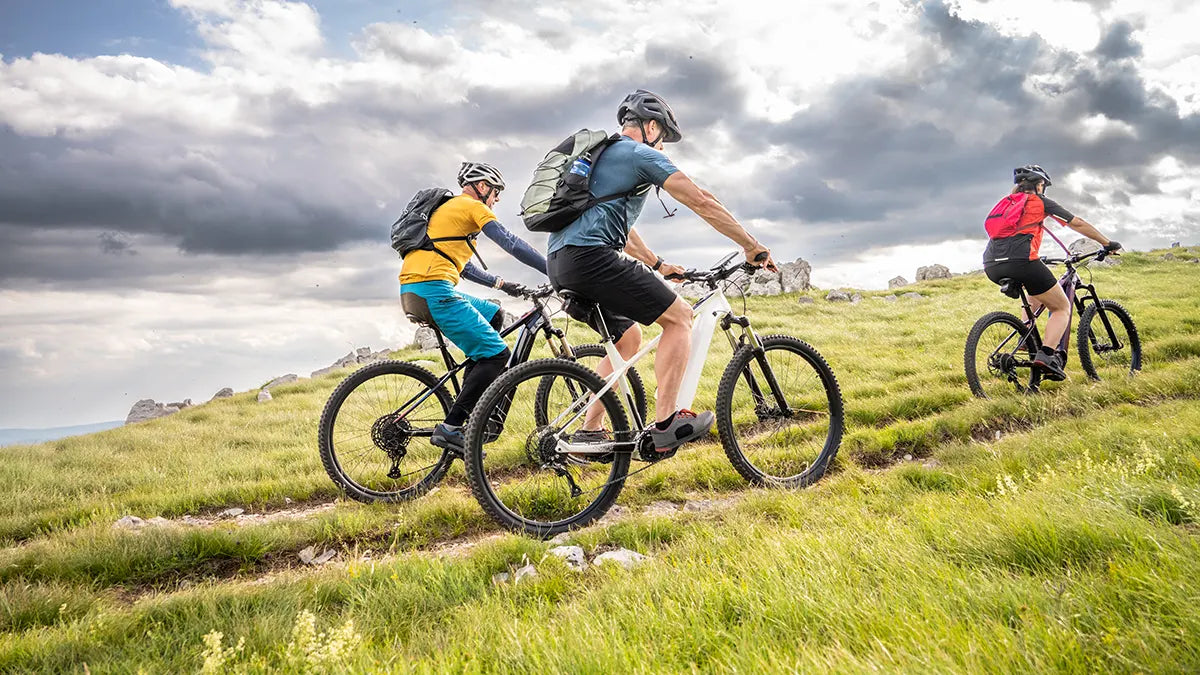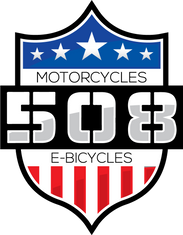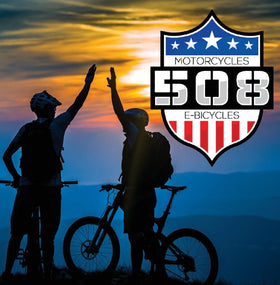
How to Choose a Mountain E-Bike for Off-Road Adventures
Mountain biking has always been about freedom, exploration, and pushing personal limits. For those who crave off-road adventures, but want a little help tackling tough climbs and long trails, electric mountain bikes offer an incredible solution.
However, with so many options on the market, it can be a challenge to find the best mountain e-bike for your needs. In this guide, the experts at E-Bikes 508 offer everything you need to know to choose a model that matches your riding style, terrain, and preferences.
What’s Your Riding Style?
- Recreational Riding
- Trail Riding
- Enduro and All-Mountain Riding
- Downhill Riding
Recreational Riding
For casual riders, comfort is more important than high performance. A lightweight frame and moderate suspension are ideal, as they provide a smooth ride without overloading you with power or features. Models with a smaller battery and moderate motor power will suit your leisurely rides while giving you a boost on hills.
Trail Riding
Intermediate riders who enjoy varied trails need a more adaptable e-bike. Look for models with balanced power output and durable components. These electric bikes provide a good balance between power and control, which makes them ideal for mixed terrain.
Enduro and All-Mountain Riding
Enduro riders require powerful electric mountain bikes that can handle challenging terrain, including steep climbs and technical descents. A high-capacity battery and robust motor will give you the power to conquer difficult trails, while full suspension ensures smooth handling.
Downhill Riding
For those who seek the thrill of downhill riding, a durable frame with advanced suspension is essential. These off-road e-bikes need maximum control and braking capabilities to navigate steep, fast descents safely. High-torque motors can make ascents easier and enable you to reach the top quickly before you fly back down.
What Terrain are You Conquering?
- Rocky Trails and Technical Terrain
- Forested Paths and Dirt Trails
- Loose Gravel and Sand
- Mixed Terrain
Rocky Trails and Technical Terrain
For rocky, uneven trails, look for an e-bike with high torque and a full suspension. This setup will enable you to navigate challenging sections with stability and confidence.
Forested Paths and Dirt Trails
For intermediate paths, a mid-range suspension and moderately powerful motor will provide the control you need without overwhelming you. This setup is versatile and works well on most single-track trails.
Loose Gravel and Sand
If you’ll be riding on loose surfaces, consider an electric off-road bike with fat tires or wider tread. These provide better grip and stability, so you can avoid slipping and maintain control over uneven ground.
Mixed Terrain
For riders who like variety, a versatile mountain e-bike with adjustable components is best. Look for a model with variable power settings, adjustable suspension, and tires suited for mixed terrain.

How Does the Class of Your E-MTB Affect Your Ride?
- Class 1: Pedal-assist only; maximum speed of 20 mph.
- Class 2: Pedal-assist & throttle; maximum speed of 20 mph.
- Class 3: Pedal-assist up to 28 mph.
Class 1: Pedal-Assist Only (Up to 20 mph)
Class 1 electric mountain bikes provide pedal assistance up to 20 mph, but they don’t have a throttle. The motor only engages while you’re pedaling, giving you a natural-feeling boost.
- Trail Access: Class 1 e-bikes are allowed on most mountain biking trails since they resemble traditional bikes in terms of control and speed.
- Battery Life and Range: Since Class 1 bikes don’t offer throttle, the battery tends to last longer, making them ideal for long rides.
- Effort Balance: These bikes offer assistance on climbs and uneven terrain, but you still need to pedal to keep the motor engaged. This can give you a solid workout without total fatigue.
- Riding Feel: Class 1 e-bikes feel closer to traditional bikes, as you’re constantly pedaling to engage the motor. This makes them popular for riders who want assistance without losing the feel of a standard mountain bike.
Class 2: Pedal-Assist and Throttle (Up to 20 mph)
Class 2 e-bikes feature both pedal assist and a throttle, allowing the motor to engage without pedaling. They’re still limited to 20 mph, but the throttle offers an extra level of control.
- Trail Access: Some trails restrict throttle usage, so always check local regulations. In places where they’re permitted, Class 2 bikes give you a bit more freedom on mixed terrain.
- Added Flexibility: The throttle allows you to take breaks without stopping entirely. This makes it easier to conquer steep hills or rough sections without constantly pedaling.
- Battery Life: Throttle use can drain the battery faster than pedal-assist alone, especially if used frequently on hills or tough trails.
- Ease of Use: Class 2 bikes are great for beginners or riders who need flexibility, as the throttle provides added help on challenging terrain without requiring continuous pedaling.
Class 3: Pedal-Assist Only (Up to 28 mph)
Class 3 mountain e-bikes are pedal-assist only but have a higher speed limit, providing assistance up to 28 mph. They don’t have a throttle, so you must pedal to engage the motor.
- Trail Access: Class 3 e-bikes face the most trail restrictions, as some trails limit motor-assisted speeds. They’re best suited for fire roads, open trails, or off-road areas where speed is less of a concern for access.
- High-Speed Performance: With a higher speed cap, these bikes are ideal for riders who want to cover long distances quickly.
- Battery Use: Maintaining higher speeds requires more battery power, which can reduce range on longer rides. These e-bikes usually come with larger batteries to accommodate speedier rides.
- Advanced Riding: Class 3 bikes can handle steep climbs with ease and maintain speed over long stretches. They’re often preferred by experienced riders looking for a faster, more powerful ride with pedal assistance.
Choosing the Right Class for Your Riding Style
- For Recreational Riders & Trail Access: Since class 1 e-bikes offer a good balance of assistance and access to most trails, they’re ideal for recreational riders and trail enthusiasts who want extra help on climbs.
- For Flexibility & Ease: Thanks to the flexibility of their throttle controls, class 2 e-bikes are perfect for beginners or anyone who needs rest breaks on demanding trails.
- For Speed & Distance: Class 3 e-bikes are best for riders looking for high-speed capabilities over long distances and open trails. They’re also great for advanced riders who want to cover a lot of ground with extra speed and power.
Key Features of an Electric Mountain Bike
- Motor Power and Torque
- Battery Capacity and Range
- Suspension Types and Travel
- Frame Material and Geometry
- Tire Type and Width
- Braking System
How Does Motor Power & Torque Affect Your Ride?
Higher torque motors are ideal for tackling steep climbs and difficult terrain. Beginners and casual riders may prefer a 250W motor, while experienced riders might need a 750W motor for the power to handle extreme conditions.
How Does Battery Capacity & Range Affect Your Ride?
A larger battery provides more range but can add weight to the bike. Make sure the battery capacity matches your adventure plans. For long-distance riding, look for a battery with high watt-hours (Wh).
How Does Suspension Types & Travel Affect Your Ride?
- Hardtail: Suitable for moderate trails, hardtail mountain e-bikes offer a lighter, simpler option for recreational riders.
- Full Suspension: For technical trails and challenging terrain, full suspension absorbs shock and provides better control. For rugged trails, consider a suspension travel of 150mm or more.
How Does Frame Material & Geometry Affect Your Ride?
Frame material affects both durability and weight. Aluminum frames are strong and affordable, while carbon fiber is lightweight but pricier. Choose a frame geometry that aligns with your riding style — aggressive riders may prefer a more forward-leaning frame, for example.
How Does Tire Type & Width Affect Your Ride?
Wider tires provide more traction on loose terrain. For most off-road e-bikes, tires between 2.4” and 4.0” wide work well for grip and stability.
How Does the Braking System Affect Your Ride?
Electric bikes should have disc brakes, ideally hydraulic for consistent stopping power. This is essential for handling steep descents safely on rough trails.
Other Features that Support Your Adventure
- Controller Unit: The controller unit enables you to make quick adjustments to pedal-assist levels and track essential metrics like speed, distance, and battery life.
- Drivetrain: High-quality drivetrains provide smoother, more precise shifting to handle steep climbs, rocky trails, and fast descents without chain slips or lag.
- Bike Rack: A sturdy e-bike rack simplifies transport, especially if your adventures take you off the beaten path.

Find the Perfect Mountain E-Bike for Your Next Off-Road Adventure
Choosing a mountain e-bike for your off-road adventures comes down to understanding your riding style, the terrain you plan to conquer, and the features that matter most. Test ride a few options to find the perfect fit, and consult with experts to ensure that your choice matches your goals.
With the right electric mountain bike, your next off-road adventure will be more exciting than ever. Visit E-Bikes 508 today to explore our selection and find the perfect ride for you.

